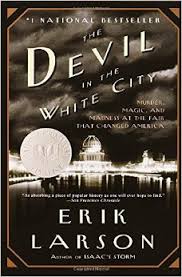
Between the covers of this book lies two completely different stories, intertwined because of proximity. Both of them really happened. Readers who enjoy American history, stories about Chicago, architectural marvels, or terrifying true crime murder mysteries will find something attractive in The Devil in the White City.
The connective force in all these little stories is, of course, The World’s Fair that took place in Chicago. In many ways, it is astounding that this Fair ever made it into existence.
The Architects had far too little time to build what was essentially an entire new city. There were many discussions about exactly which architects would be involved, because where the architect was from apparently said more than could be expected at first glance. It mattered to so many people how many architects from the East Coast were selected, compared to how many were from the Midwest, for example.
It was hard to get architects, once invited, to accept the invitation because the general consensus was that this Fair would not upstage the previous World’s Fair in Paris. That was the Fair where the Eiffel Tower was unveiled, and, up until right before the Chicago World’s Fair opened, no one had any idea what was going to be built that could possibly be more impressive than that. The general belief was that this Fair would be a gigantic failure, that it wouldn’t be complete by opening day, and that it would bring shame to not only the architects involved, but also the city of Chicago, and America itself.
Imagine being the guy in charge of coordinating all that! Larson does a wonderful job of dropping you inside the heads of the the men in charge of this huge project. Eventually, these men (and a few women) surpass all odds, and create more than just a Fair. They create a “White City”, clean and shining, wondrous and unforgettable.
I realize a quick google search will, very likely, give you some quick facts about exactly what wonders appeared there. However, I suggest readers refrain from doing just that. Don’t spoil it for yourself, be as surprised as the Fair goers of the time, the book is more fun that way.
If you want an example of “Chicago Politics” at it’s finest, look no further than the chapters describing how the site for Fair was selected. It seemed to me that anyone who had a little bit of power or political sway stepped up to argue about how their precinct was, in fact, the very best place the Fair could possibly be located at.
The eventual location, although pretty, became something of an architectural nightmare. The land was, in places, a quagmire, in other places impossibly hard to dig into. The weather itself seemed to be fighting the architects, with stifling heat, mountains of snow, and winds that insisted on tearing down freshly built structures.
If you’ve ever lived in or near Chicago, this will come as no shock. Readers who haven’t will get a little taste of what “Chicago Winter” can be.
The Fair brought jobs, in a time when jobs were incredibly scarce. Not only did the Fair employ builders, and masons, and painters, and architects, etc… it also allowed other jobs to sprout around it. Hotels, boarding houses, apartments, and restaurants near the Fair flourished, long before the Fair opened.
Everyone wanted to be in Chicago. It was not unusual for young women to take their newly learned office skills, and move to Chicago, alone, to start a life. It was these combination of factors that allowed a very dark and twisted soul to find endless prey.
A man, who went by a series of fake names, went to Chicago, built a massive house with some peculiar features, and used his innate charisma to get everything he wanted out of people. He bilked people out of money, by promising to pay for his purchases “later” when his situation got better, and also by creating a fake person who “owned” the property.
Women, especially young women, quickly became enamored with this man, and he had no shortage of secretaries, lovers, and even wives. Larson also puts the reader inside this man’s head, and it’s a creepy and disgusting place to be.
This man was evil incarnate, and I can think of few better examples of what it means to be a sociopath. Because Chicago was so big, and because no one who thought they knew this man would ever think him capable of anything nefarious, he literally got away with murder, over and over again.
The brilliance in this book is in the juxtaposition. Larson gives the reader one or two chapters about the “White City”, and sandwiches them between some chapters about “The Devil”. The contrast is striking.
This book review of The Devil in the White City – by Erik Larson is a post written by Jen Thorpe on Book of Jen and is not allowed to be copied to other sites.
If you enjoyed this blog post please consider supporting me on Ko-fi. Thank you!
